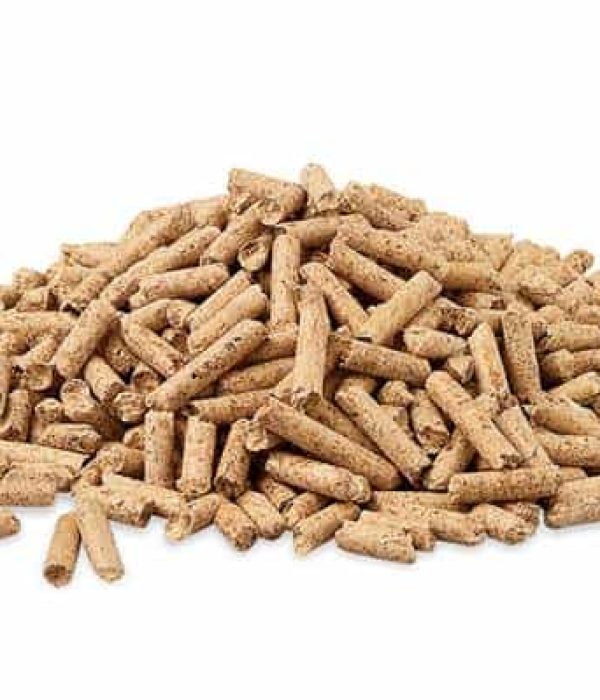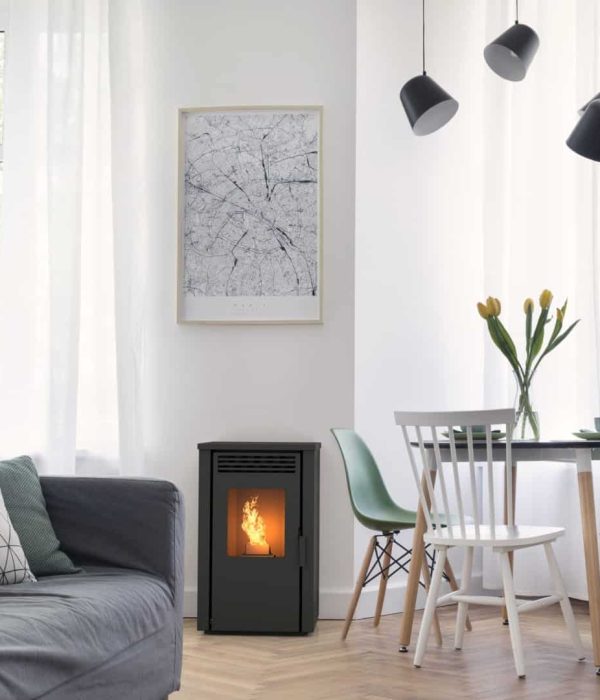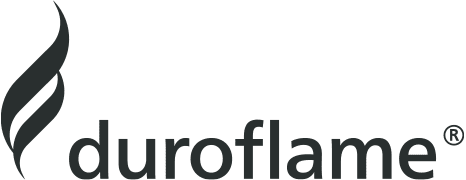Everything about pellets
Duroflame
All about pellet stove pellets
High-quality pellets consist of pure wood waste left over from machining processes in sawmills. No artificial binders or glues are added to the pellets, making them extremely pure burning materials. The binder of pellets is formed by the resins naturally found in wood. Due to the high pressure in the production process and the natural resins, pellets hold their shape well.
The small pellets are clean and 100% CO2 neutral. The exact heat output also depends on the type of pellets you use. There are different types on sale, which can also differ greatly in terms of quality. For example, there is a difference between so-called white and brown pellets, different certifications and pellets with different properties.

Pellets can be broadly divided into four groups
Biopellets
These are pure pellets made from chipped wood. They contain no additives.
General pellets
These pellets can be made from different types of wood. They may contain additives, but no chemicals.
Mixing pellets
This pellet type is a mix of wood species, bark and wood dust. They have a somewhat lower efficiency than biopellets and regular pellets.
Bark pellets
Bark pellets contain bark and are often cheaper than other types of pellets. The downside is that they often do not burn as well and for as long. They usually contain more sulphate and moisture than biopellets or ordinary pellets, and this results in more ash.
Pellets can also be distinguished by colour; namely white and brown pellets
White pellets
White pellets consist of pure softwood and are often made of pine or ash. On average, they are a bit more expensive than brown pellets and also guarantee very clean combustion. White pellets do have a slightly lower heat output than the brown ones.
- Produced from softwood only
- Clean combustion
- High energy value
- Low ash content
- Higher consumption
- Higher priced
Brown pellets
Brown pellets are made from a diverse range of hardwood species. Oak is particularly popular. Sometimes these pellets are also a blend of softwood and brown-coloured sawdust. Brown pellets burn hotter and less brightly. They are ideally suited for heating larger spaces.
- Produced from hardwood combined with softwood
- Less clean combustion
- Highest energy value
- Higher ash content
- Lower consumption
- Lower priced
First of all, look at the certification
The history of the world-leading wood pellet certification system is, of course, closely linked to the history of the commodities it certifies. Wood pellets originated during the oil crisis of the 1970s, when demand for alternatives to fossil fuels was high. Yet it was not until the 1990s, amid growing environmental concerns, that wood pellets were seen as a reliable alternative energy source in Europe. Since then, production and consumption have grown steadily and wood pellets are now truly considered a high-quality renewable fuel.
With the success of wood pellets came important questions. How do you ensure transparency and comparability for consumers? And most importantly, how to increase the quality of pellets globally? The questions were somewhat answered with the creation of a European standard for wood pellets in 2011 (EN 14961-2), which had been succeeded a few years later by the international standard (ISO 17225-2).
What does ENplus® certify?
Within the industry, ENplus® has become a global synonym for quality in less than a decade. The success of the certification scheme is largely due to its broad scope, covering the entire wood pellet supply chain. From the start of production to the delivery process, it ensures that all those involved have detailed guidelines, efficient control procedures and dedicated training to guarantee a high and consistent level of quality.
Of course, the pellets themselves must also meet various technical specifications. In addition to length and diameter, ENplus® pellets are also tested for mechanical durability, percentage of fine particles, bulk density, ash and moisture content, calorific values and percentage of additives. Everything is done to ensure that pellet appliances using ENplus® pellets perform optimally, without problems and for a long time.

Top of the line: the ENplus® certification system
In this context, the ENplus® certification system was established in 2011. Originally designed by the Deutsches Pelletinstitut, the certification system introduced ENplus® quality classes and more stringent requirements than those of European and international standards. Thanks in part to the active support of European partners, ENplus® quickly became a renowned certification system both in Europe and beyond. Its success contributes greatly to the much-needed harmonisation and standardisation of the pellet market.
Confidence is good - DIN certification is better!
To ensure the constant safety of products for users and consumers, DIN CERTCO offers certification products that meet specific legal requirements. The aim of this DIN certification is to provide proof of conformity in the exact areas deemed necessary by stakeholders.
DINplus, a PLUS for products that burn fuel with low emissions
Tested, certified and monitored product quality is represented by the internationally recognised and neutral DINplus seal of approval. Manufacturers can also demonstrate that their products exhibit quality characteristics that exceed standards with the DINplus seal of approval. Dinplus certification shows that fireplaces are environmentally friendly with particularly low emissions.
Fireplaces must meet particularly strict requirements with regard to emission limits for carbon monoxide, nitrogen oxide, hydrocarbons and dust and prove exceptional efficiency in terms of burning solid fuels. They also meet specific quality criteria for sustainable products.
A routine test is carried out every 2.5 years to confirm that products have maintained a high level of quality.
Testing and assessment
After a positive assessment result, DIN CERTCO issues a certificate valid for five years. An individual registration number on the certificate serves to protect against impermissible use of the mark.
Dutch reliability: Better Biomass
Better Biomass is managed by NEN, the Netherlands Standardisation Institute. As a member of CEN and ISO, NEN ensures that the sustainability criteria and conformity assessment processes are and remain aligned with the relevant European (EN) and international (ISO) standards.
The Better Biomass certification scheme is accepted by the Council for Accreditation (RvA), which is a member of EA and IAF. Certification audits are carried out by independent certification bodies accredited for the Better Biomass certification scheme.
Besides certification, what should I look out for when buying pellets?
Combustion value
The best pellets for your pellet stove have a minimum energy value of 5 kWh/kg. A white grain often indicates wood that burns faster but brighter. A brown grain often means a harder wood, which burns longer but less brightly. The heat value or calorific value of the pellet pellet indicates how much 1 kilo of wood pellets gives off in kilowatt-hours (kWh) or megajoules (MJ). The higher the calorific value, the more the pellets yield and thus you get a higher efficiency. Most wood pellets have a kWh/kg between 4.6 kWh and 5 kWh.
Ash value
Go for a product with the cleanest combustion possible. Ash causes loss of efficiency and more maintenance on your stove. Not every provider shows the ash value. Do you often need to clean the window and stove inside? Then try a different type of pellet so you can compare. With most providers, an ash value of 0.7% is common. Ash in the pellet stove provides insulation. This is because the ash residue will eventually stick to the inside of your stove. As a result, the heat from combustion does not enter your room, but is lost. A higher ash value therefore comes at the expense of efficiency in the long run.
Moisture value
Dry combustion results in less smoke. Lots of moisture causes flue and filter problems, among other things. Often the moisture value is not described. Do you suffer from smoke formation? Try a different type of pellet to see if this makes it better. Moisture in combustion causes smoke formation and directly affects the effective heat. So very important! The less moisture, the better the pellets burn.

